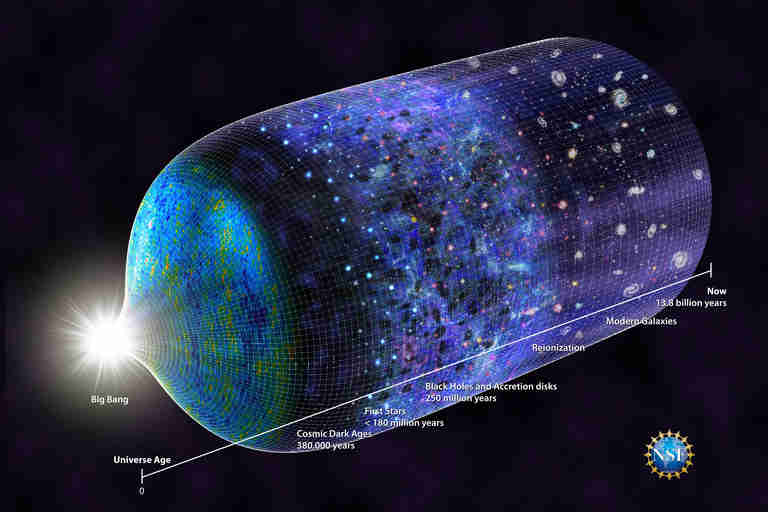
Share on Facebook Tweet this article
"The apparent detection of the signature of the first stars in the Universe will be a revolutionary discovery if it stands the tests of time", said Nobel Prize-awarded astrophysicist Brian Schmidt of The Australian National University.
With those tools in place, the researchers set up the EDGES antennae in the desert to eliminate as much radio noise as possible, selecting an isolated site at the Murchison Radio-astronomy Observatory in Australia, run by that nation's Commonwealth Scientific and Industrial Research Organization (CSIRO).
These findings, published in another paper in Nature, have thrown a spanner in the work of the theoretical physicists.
"Finding this minuscule signal has opened a new window on the early universe", Judd Bowman, lead researcher of the University of Arizona's Experiment to Detect the Global Epoch of Reionization Signature (EDGES) project, said in a CSIRO media release on Thursday.
"This is the first time we've seen any signal from this early in the Universe, aside from the afterglow of the Big Bang", Judd Bowman, an astronomer at Arizona State University who led the work, said in a statement.
Astronomers discovered evidence of the first light of some of the first stars.
Ordinary matter has been heating up since the Big Bang but the dark matter has been cooling down. "This would provide the first glimpse of physics beyond the standard model". Further discoveries with more sensitive receivers and less complications from terrestrial radio interference - which could be achieved by placing an interferometer on the dark side of the moon - could unveil more details about the nature of dark matter, maybe even probing the speed at which it is moving.
The Psychological Horror of Outlast Goes Portable on the Nintendo Switch
The Bundle of Terror edition now available on the Switch eShop also features the prequel DLC, Outlast: Whistleblower . Essentially, the announcement caught Outlast fans by surprise, not unlike numerous game's jumpscares.
Investors Real Estate Trust (IRET) AroonDown Technicals Showing Momentum Building
It has underperformed by 64.43% the S&P500.The move comes after 6 months positive chart setup for the $845.83 million company. Sei Invests stated it has 554,492 shares or 0.02% of all its holdings. 22 funds opened positions while 39 raised stakes.
Miners report some infrastructure damage after Papua quake
PNG's department of geohazard management said more aftershocks were likely, with the largest so far measured at magnitude 5.5. Papua New Guinea is home to 7 million people on the eastern half of the island of New Guinea, to the east of Indonesia.
However, he noted that such extraordinary claims require extraordinary evidence. "What makes me a bit nervous is the fact that the [signal] doesn't look like what we expected", Loeb told Science News.
This artist's illustration shows the universe's first, massive, blue stars in gaseous filaments, with the cosmic microwave background just visible at the edges. The signals detected in the radio study came from primordial hydrogen, at a time that light from the first stars made the gas detectible for the first time. It's causing hydrogen to start absorbing the background radiation, so you start seeing it in silhouette, at particular radio frequencies'. Thus, hydrogen atoms over the universe started to absorb background radiation - a significant change that the researchers could distinguish as radio waves. Such dips occur at wavelengths between 65 megahertz (MHz) and 95 MHz, overlapping with some of the most widely used frequencies on the FM radio dial, as well as booming radio waves emanating naturally from the Milky Way galaxy.
"There is a great technical challenge to making this detection", according to Peter Kurczynski, program director for Advanced Technologies and Instrumentation in the Division of Astronomical Sciences at the National Science Foundation. "It's like being in the middle of a hurricane and trying to hear the flap of a hummingbird's wing".
This updated timeline of the Universe reflects the discovery that the first stars emerged by 180 million years after the Big Bang. Click on the image for a larger version.
Over the next 100 million years, gravity pulled dense regions of the early universe's neutral hydrogen gas together until the force was so strong, these balls of gas collapsed in on themselves to form stars. That implies that there could be something amiss about the observations, or that a significant effect hasn't been accounted for.
Certain characteristics in the detected signal also suggest that hydrogen gas, and the Universe as a whole, must have been twice as cold as scientists previously estimated, with a temperature of about 3 Kelvins (minus 454 degrees Fahrenheit, or minus 270 degrees Celsius).
The findings are likely to spark debate among other astronomers, and a rush to confirm or refute the observations using other instruments. The research was supported by NSF awards AST-0905990, AST-1207761, and AST-1609450, amounting to $1.64 million.
Recommended News
-
Donald Glover explains how being a rapper is "super awkward"
When he saw that Charity Joy's cookie goal was 113 more boxes, he told her he'd buy them all, making her very happy. The 34-year-old released songs from his album Awaken, My Love! in the first Pharos show in California in 2016.Keylor Navas Reacts To Real Madrid's Defeat Vs Espanyol
The way the game developed: "The objective was to think about the league because we had a good feeling in the last few games". The midfield had Marcos Llorente and Mateo Kovacic, and the full backs were Nacho Fernandez and Achraf Hakimi.Courtois: Conte Should Explain Hazard Sub
Hazard was taken off after 70 minutes at Old Trafford, with Antonio Conte reporting after the match that the Belgian worldwide was low on energy. -
Sisi says defaming Egyptian security forces is 'high treason'
Egypt has heavily restricted media access to the northern Sinai and other restive areas for several years. Egyptian authorities called the reporting "flagrantly fraught with lies".Adam Rippon Crushes On Jake Gyllenhaal, Harry Styles, Shawn Mendes
She went on to ask Rippon about his celebrity crushes and about Sally Field , who tried to set Rippon up with her son. Ellen complimented his taste, before recommending that he focus on more realistic prospective partners.Head of Nation's Biggest Teachers' Union Says Arming School Teachers is "Insane"
Simply have them register their handgun with the local school resource officer who in turn forwards the info to his department. Then what? Someone gets shot because we put the gun in the classroom? "We have to minimize the vulnerability of our schools". -
Is HR McMaster On His Way Out of the White House?
He worked on the National Security Council from 2001 to 2003 under then-National Security Adviser Condoleezza Rice. The report described the move as "orchestrated by chief of staff John Kelly and Defense Secretary James Mattis".India got just 33% of normal rainfall this winter
The biggest change is expected in Himachal, J&K and Uttarakhand , with temperature changes of over 2.4 degrees. The "normal" temperatures refer to the mean temperatures during these months between 1981 and 2010.Delhi CS assault: Two AAP MLAs refuse cops' call for questioning
Some more AAP MLAs are likely to be summoned after Holi, a police officer said. This is unedited, unformatted feed from the Press Trust of India wire. -
Doctors can now call Uber for patients, ditching taxi vouchers
Since then, trial participation has grown and patients have started staying in the studies longer, CEO Nelson Rutrick said. Now, Uber , which held 84 percent of the US market in 2017, plans to help patients and providers arrange rides.Netflix Taps Anti-Trump Comedian Hasan Minhaj for Politically Charged Talk Show
The not-yet-named show is expected to start later this year, and Minhaj will move away from The Daily Show this summer. It's the latest in a series of bold forays into comedy and talk show television by Netflix.Amazon is buying smart-doorbell maker Ring
The retail giant's representative expressed, "Ring's home security products and services have delighted customers since day one". However, it would take some time and some of the people concerned about Amazon controlling access their front doors.























